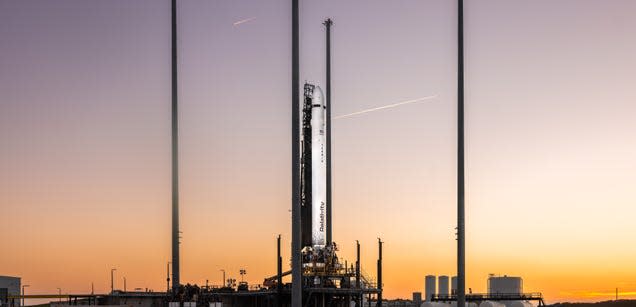Relativity Space aims for a record-breaking debut launch of the Terran 1 rocket

If the Terran 1 rocket makes it to orbit during its debut flight on March 8, it will be the first time Relativity Space has left the planet since the rocket-maker was founded in 2015.
It will also be the first time a rocket fueled by methane has gone to orbit. Meanwhile, with 85% of the Terran 1 built with 3D printing, it is arguably the largest metal object ever made using that technique.
Read more
And if it all works, this will be the first time that a private company has reached space without blowing up its brand new rocket.
The stakes for a successful launch for Relativity
There’s a saying in rocketry—when the countdown clock hits zero, a million things can happen, and only one of them is good. Josh Brost, a senior vice president at Relativity, mentioned it to me while explaining the company’s outlook on the test flight, which is scheduled for 1 pm ET on March 8 and will be broadcast live.
Terran 1: Launching The World’s First 3D Printed Rocket
Sharing live video of a test flight is a gutsy move, given the record of the company’s predecessors and rivals: SpaceX’s first three launches failed. Rocket Lab, the most successful small launch company, had its first flight go awry. So did debut attempts by Virgin Orbit, Astra, Firefly, and ABL Space Systems.
There is no payload on this rocket, other than a metal ring that was one of the first objects printed in Relativity’s factory.
A successful launch will be a major validator for one of the first rocket companies founded in the wake of SpaceX’s success. The two co-founders, CEO Tim Ellis and former CTO Jordan Noone, raised their first $500,000 with a cold email to Mark Cuban explaining their plans to build an entire factory based on 3D printing. At their last capital raise, in 2021, the company was valued at more than $4 billion.
And failure? Well, it would teach Relativity’s engineers a lot, but might disappoint customers it has struck deals with, including NASA, the US Space Force, and the satellite operators OneWeb and Iridium.
This is a launch for learning
Relativity has something of an insurance policy. In 2021, the company pivoted from focusing on this rocket—a “small” vehicle at 110 ft tall—to begin building a rocket called the Terran R that is more than twice as large. Trends in the satellite industry toward heavier payloads, and the lack of a clear competitor for SpaceX’s Falcon series of rockets, meant a bigger vehicle was a better investment.
That decision takes some pressure off this launch. Brost says the company is mainly looking for proof points—that the 3D-printed structure withstands the rigors of flight, that the engines and plumbing work, and that the ground systems keep the rocket healthy and fueled up until the moment of ignition. Brost suggested that if the vehicle makes it past “Max Q,” the time in a rocket’s flight when it must withstand the largest amount of stress, it would be a major validator, as would reaching the point where the rocket’s booster and its second stage separate.
Following in the footsteps of SpaceX
The two rockets being developed by Relativity share common technologies and design elements. This test flight could be seen simply as a way to develop technology for the Terran R. That’s how it worked out for Elon Musk’s SpaceX, which only flew its Falcon 1 rocket for one paying customer before mothballing it and focusing on the larger Falcon 9.
Indeed, whether it succeeds or fails, this could be the only time we see the Terran 1 attempt to launch. While the company has agreements with several customers to use the vehicle, Brost says that the company will analyze the results of the test before speaking to its customers about the right way to put their payloads on orbit.
Relativity has big ambitions—to launch hundreds of satellites, to launch the first private mission to Mars, and eventually build a factory there. But it all has to start somewhere—with nine engines igniting on a Cape Canaveral launchpad and breaking free of gravity.
More from Quartz
What higher H-1B fees will mean for Indians hoping to work in the US
More than half of US nursing homes are unprofitable—and it's about to get a lot worse
Sign up for Quartz's Newsletter. For the latest news, Facebook, Twitter and Instagram.

